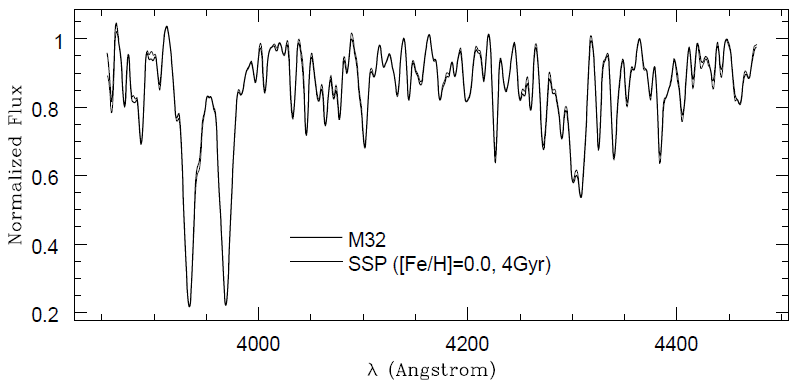V99 Blue/Red models
Tarfiles with all the predictions for this set of models can be retrieved from here:
| V99 models (v11.0) |
We present here an updated version of the first evolutionary stellar population synthesis model predicting SEDs for single-age, single-metallicity stellar populations (SSPs) at resolution ~1.8Å (FWHM) in two reduced but very important spectral regions around 4000 and 5000Å. The input stellar database is composed of a subsample of ~500 stars selected from the original Jones (1999) spectral library. This is the first time that such an evolutionary model has employed such an extensive empirical stellar spectral library, at such high resolution, for supporting its SED predictions.
The SSP spectral library is mostly safe for the range of  metallicity -0.7<=[Fe/H]<=+0.2. Among other aspects, these models showed the advantages of working with indices that are not restricted to the Lick/IDS system. These model spectra can be used to analyze the observed galaxy spectrum in a very easy and flexible way, allowing us to adapt the theoretical predictions to the characteristics of the data instead of proceeding in the opposite direction as, for example, we must do when transforming the observational data for using model predictions based on a particular instrument-dependent system of indices at a specific resolution. The synthetic SSP spectra, with flux-calibrated spectral response, can be smoothed to the same resolution as the observations or to the measured galaxy internal velocity dispersion, allowing us to analyze the observed spectrum in its own system. Therefore, we are able to utilize all the information contained in the data at their spectral resolution. After performing this step, the entire observational spectrum can be compared at one time, or the analysis can be done by measuring a particular set of features in the synthesized and the observational spectra rather than by trying to correct the latter from broadening or instrumental effects.
metallicity -0.7<=[Fe/H]<=+0.2. Among other aspects, these models showed the advantages of working with indices that are not restricted to the Lick/IDS system. These model spectra can be used to analyze the observed galaxy spectrum in a very easy and flexible way, allowing us to adapt the theoretical predictions to the characteristics of the data instead of proceeding in the opposite direction as, for example, we must do when transforming the observational data for using model predictions based on a particular instrument-dependent system of indices at a specific resolution. The synthetic SSP spectra, with flux-calibrated spectral response, can be smoothed to the same resolution as the observations or to the measured galaxy internal velocity dispersion, allowing us to analyze the observed spectrum in its own system. Therefore, we are able to utilize all the information contained in the data at their spectral resolution. After performing this step, the entire observational spectrum can be compared at one time, or the analysis can be done by measuring a particular set of features in the synthesized and the observational spectra rather than by trying to correct the latter from broadening or instrumental effects.